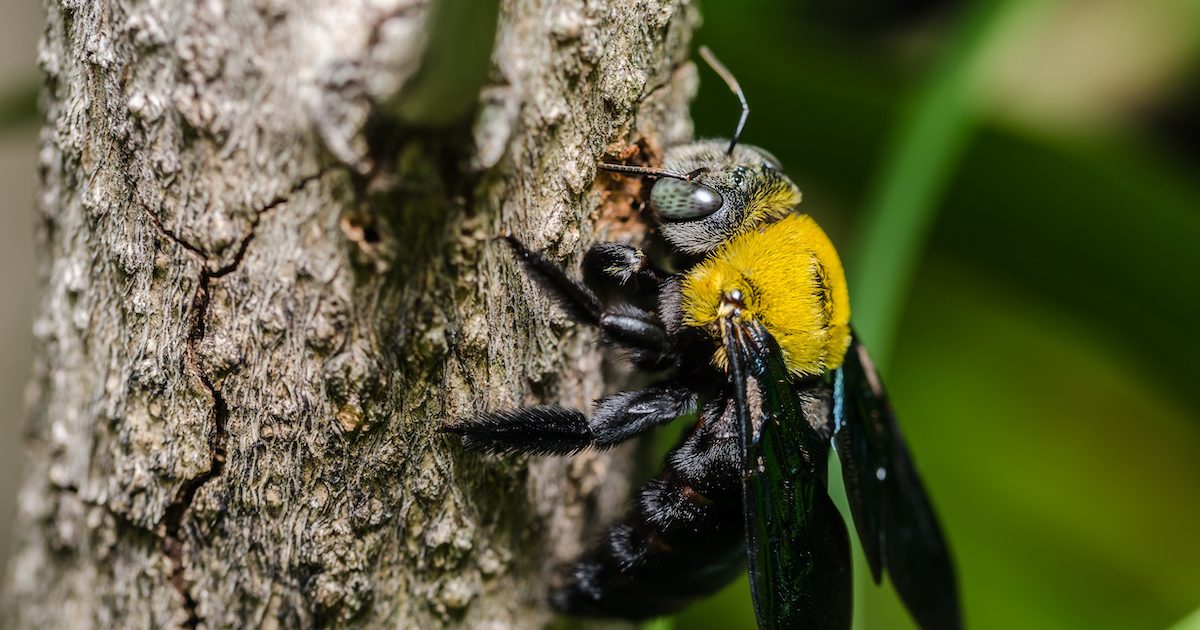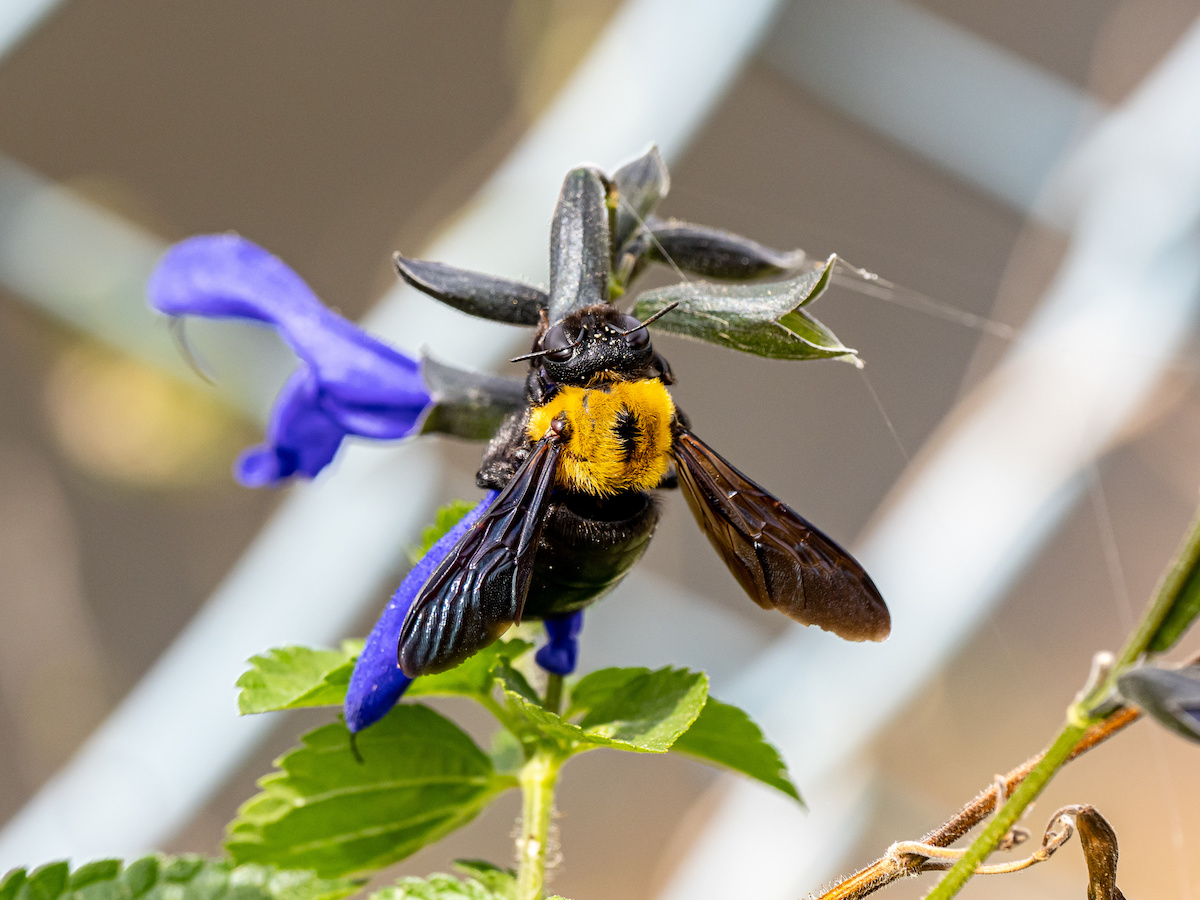
In the spring, as the days get longer and many flowers are in bloom, you may notice buzzing visitors in your yard. Some of these insects are here to make sure that the flowers get pollinated. Others are here to take advantage of the blooms and make sure that their eggs are ready to hatch when the flowers die in the fall. But one group of insects is here to help you: the carpenter bees! But should you get rid of carpenter bees?
When you see a carpenter bee, you might instinctively swat at it or reach for the insect spray. While most people don’t want bees buzzing too close to them, their kids, or pets, the carpenter bee really isn’t all that bad.
In this guide, we’ll explain everything you need to know about carpenter bees—good and bad! If you need to get rid of them, we have some suggestions to help you get rid of them safely and effectively.
What are Carpenter Bees?
They are members of the bee family, Anthophila. These are very large bees with a dark brown to shiny black body, black and yellow markings on the abdomen, and a large white “apron” on their back around their legs.
Female carpenter bees typically have a black abdomen, while the males have more yellow markings. Both males and females are black with a yellow pattern.
These solitary insects do not nest in large colonies, like bumblebees and honey bees, they nest in small groups inside of wood, chewing through it to make their homes.
They are commonly found in the spring and are beneficial because they help with pollination.
Signs that You Have Carpenter Bees
One common sign of carpenter bees is small holes in wood structures, especially unpainted and weathered wood. Female carpenter bees produce these holes to lay eggs in wood.
It takes a lot of time and energy for females to build new nests inside of wood. This is why carpenter bees tend to use the same nest from season to season, rather than creating an entirely new nest.
Another sign of carpenter bees is when you find small piles of sawdust or pollen on the surface of a structure. This is the result of the bees collecting materials to bring back to their nests. Be sure to check for these piles of pollen or sawdust inside of your home as well as outside on the structure itself. In some cases, carpenter bees can cause small cracks in the wood.
You may also notice carpenter bees hovering around your yard outside. These are territorial males that are likely guarding a nearby nest. But don’t worry, they can’t sting you. Their entire purpose is to look intimidating and chase off other insects.
Carpenter Bees vs. Bumble Bees: What’s the Difference?
Many people confuse carpenter bees with bumblebees, and understandably so. They are both large bees that look alike and behave in similar ways. However, there are a few differences between carpenter bees and bumblebees.
First, carpenter bees spend a lot of time by themselves and do not nest in large groups. This is a major difference in comparison to the bumble, which lives in colonies with up to 500 insects.
Carpenter bees burrow into wood to build their nests, while bumblebees prefer to build their nests close to the ground in existing shelters like compost heaps or leaf piles.
Both bees are very large and black, however, bumblebees are fuzzy all over and are characterized by a yellow band around their abdomen. Some people refer to bumbles as flying teddy bears.
Finally, carpenter bees are usually found flying near wooden structures like decks and fences while bumblebees are most often spotted near flowers.
Stinging Habits of Carpenter Bees and Bumble Bees
If you’re afraid of bees, there’s a little bit of good news when it comes to the stinging habits of carpenter bees and bumblebees.
Neither type of bee is aggressive. In fact, male carpenter bees do not have stingers. The females can sting but rarely do so and only when provoked.
This is very similar behavior to the bumblebee. Male bumblebees do not sting, but the females will sting and can do so repeatedly.
The bottom line is that if you do not provoke the female bees of either species, you likely will not have problems.
Are Carpenter Bees Good to Have Around?
Carpenter bees make great pollinators. They help to pollinate flowers by collecting pollen and delivering it. Pollen is what plants need to produce fruits and seeds. If you want a fruit or a seed to come to maturity, the pollen has to be delivered to the plant.
Carpenter bees can help farmers by pollinating their crops. They can also help to make your yard look more lush and green. They are beneficial insects that can be easily attracted to your yard with flowers.
Do Carpenter Bees Destroy Your Home?
Carpenter bees are typically not a threat to people as they fly around or hover near your porch, however they can cause damage to your home if they choose to nest in it.
Carpenter bees need to nest in wood, which means they will target any type of wood around your property, including your siding, deck, or fence. They chew tunnels through the wood to make nests, which can cause damage if left undetected.
A large number of tunnels can weaken the structural integrity of the wood, especially if water enters and accelerates the rotting. Fecal matter from the bees can stain your wood and the presence of the bees can attract woodpeckers which can cause even more damage.
Luckily, there are ways to discourage carpenter bees from staying away from your home without killing them.
How to Get Rid Of Carpenter Bees
One way to protect your home from carpenter bees is to provide them with an alternative nest in your yard. Construct a nest out of cardboard or toilet paper tubes, and place it in a tree. Place flowers around the cardboard tubes to attract carpenter bees to your creation.
If you prefer to get the bees off of your property altogether, try spraying essential oil such as peppermint or eucalyptus anywhere there is evidence of nesting. Carpenter bees do not like strong smells so this will encourage them to find a less pungent place to burrow.
Another theory is that carpenter bees do not like loud music. While this won’t get rid of them completely, it can keep them away while you spend time outside. Although you may not want to try this method if you have nearby neighbors.
The easiest way to deter carpenter bees is to treat or paint any wood structures near your home. Carpenter bees are much more attracted to old, rotting, or untreated wood. Any wood that is in poor condition needs to be removed from your property to avoid carpenter bees.
Carpenter bees prefer to return to the same nests year after year, so if you do find burrow holes in your wood plug up the hole right away. This will prevent the bees from returning, plus it will stop other pests, like termites from moving in.
Get Help with Carpenter Bees with Drive-Bye Exterminators
Carpenter bees can be a beneficial insect for your yard. They are helpful pollinators and will help keep your fruits and vegetables healthy. Carpenter bees are not aggressive and will only sting if handled inappropriately. They cause very little harm to humans and can even be beneficial in fighting pollen allergies. There are many ways to attract these helpful bees to your yard, although you don’t necessarily want them to nest in old wood near your property.
When it comes to getting rid of carpenter bees, prevention is the best course of action. This means taking action when you have old wood decks, patios, and fences that are in poor condition. This wood acts as a magnet to carpenter bees that seek to tunnel and make nests within. If carpenter bees have no place to nest, they aren’t going to hang around your property for long.
Are you desperate to get rid of carpenter bees? Drive-Bye Exterminators can help. Please contact our office before you attempt to use insecticides to get rid of carpenter bees. We can try to help you humanely remove the bees so they can continue pollinating our world. They are important to our Florida environment!







